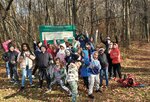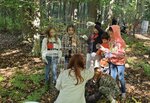



A Bucks County nonprofit committed to protecting landscapes is partnering with Keystone Elementary School in the Bristol Township School District to teach nature-loving students about the environment through wildlife tracking and protection projects.
Children at the school, located in Croydon, have opened their eyes a little further in astonishment and curiosity after working with and learning from the nonprofit Heritage Conservancy, school officials say.
The Doylestown-based conservancy recently installed a tracking tower, part of the international Motus Wildlife Tracking System, atop the elementary school.
Keystone is also located next to the Croydon Woods Nature Preserve — one of the last remaining Atlantic Coastal Plain Forests in Pennsylvania. It is protected by Heritage Conservancy.
The Motus Wildlife Tracking System is a collaborative network with international researchers sharing information from towers about the movements of tagged animals.
Croydon Woods “provides important habitat for threatened species, as well as stopover habitat for migratory species that use the Delaware River and Atlantic Flyway,” said Shannon Fredebaugh-Siller, community engagement programs manager at Heritage Conservancy.
The nonprofit recently brought Keystone second graders to Croydon Woods for a field trip. They participated in a bird migration obstacle course where they pretended to be birds flying past Croydon Woods to warmer climates.
“Students were excited and fascinated that bird movements could be tracked this way and to learn that there is a tower on their school helping to track birds,” Fredebaugh-Siller said.
Kati Bryson, who teaches fourth grade at Keystone, said her students look forward to spending time outside and experiencing nature in a different way with Heritage Conservancy.
“They truly develop a love of nature and feel that they can have a huge impact in the environment,” Bryson said.
The tracking tower has currently had nine detections of five different bird species. Not only have students been learning about the importance of habitat to threatened species and about migrating species and the tracking system; but they also have had a hand in protecting their planet through the Tree Guardian Program.
That’s a new program the Heritage Conservancy and Keystone Elementary School are offering to randomly selected fourth and second graders. Students worked in groups to install a small protective fence around native tree seedlings in Croydon Woods.
“Protection of young trees helps to deter deer from browsing the plants in the understory and supports forest regeneration, watershed protection, improves wildlife habitat and will offer educational features along the trail for visitors,” said Fredebaugh-Siller. “Naturally established seedlings tend to have a higher success rate and require less maintenance than planting a new tree at the site.”
Students learned about the type of native tree, how to identify it and why it is important to protect the trees and the forest. Student researchers will visit the trees throughout the school year to take data measurements and monitor their growth.
“I love trees!” student Alexis Prickett said while exclaiming how interesting they are to learn about. “I also really liked learning about macroinvertebrates when our class visited Glen Foerd last year, for our ‘cross watershed’ project.”
Founded in 1958, Heritage Conservancy is committed to educating young people and getting them enthusiastic about the world with its “Learning Beyond the Classroom” program.
Topics involving wildlife, habitats, plants, watersheds and other natural sciences are taught in small groups. Subjects like art, math, physical activity, history, environmental stewardship, and social and emotional learning are incorporated as well.
“I learned how not to hurt the trees,” Keystone Student Autumn Rink said. “We can put barriers around them to protect them from deer and other animals.”
“The students understand the lessons and feel that they are a part of the conversation,” Bryson said after watching her pupils interact with the nonprofit.
In the last year, Heritage Conservancy has invested in growing its community outreach and education mission by adding capacity to build new programs with additional schools and grades in the Bristol Township School District. These include an after-school Nature Club at Armstrong Middle School and an environmental science club at Truman High School.
“Using the outdoors as a classroom and/or bringing the outdoors into the classroom provides moments of awe and wonder, which ignites the natural curiosity to learn in each one of us,” Fredebaugh-Siller said.
Heritage Conservancy owns and manages more than 50 properties, holds conservation easements on more than 250 properties and actively pursues habitat restoration initiatives across the region. The nonprofit interacts with thousands of community members and students to connect people to the environment and history of the area.
Since its establishment, Heritage Conservancy has worked to protect more than 16,000 acres of open space, farmland, wildlife habitat and important watershed areas in the county and surrounding ones.
For more information visit https://heritageconservancy.org/.
Join our readers whose generous donations are making it possible for you to read our news coverage. Help keep local journalism alive and our community strong. Donate today.